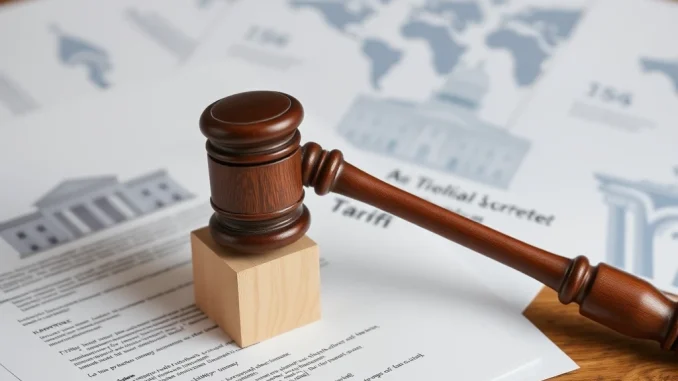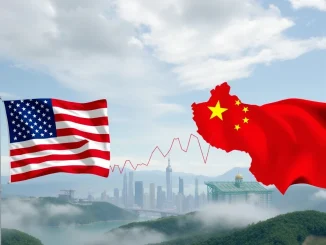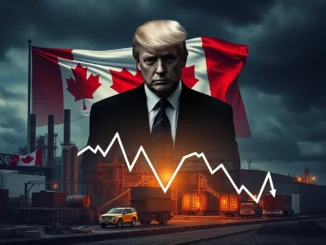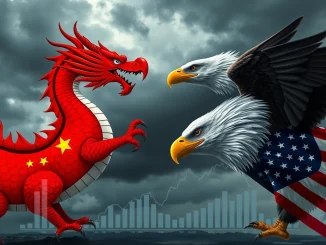
In the dynamic landscape of global finance and policy, where events far removed from digital currencies can still send ripples through market sentiment, a significant development in the U.S. legal system has captured attention. While not directly involving Bitcoin or blockchain, a recent US court ruling tariffs decision carries weight for anyone watching the interplay between executive power, trade policy, and legal challenges. For those in the cryptocurrency space, understanding these broader economic and regulatory dynamics provides crucial context.
What’s Behind the US Court Ruling Tariffs?
A U.S. federal court has determined that former President Donald Trump exceeded his legal boundaries when imposing certain tariffs, specifically those sometimes referred to as the “Liberation Day” tariffs. According to reports, the court found that the authority used for these specific Trump trade tariffs, derived from the International Emergency Economic Powers Act (IEEPA), was improperly applied. This ruling doesn’t dismantle all Trump-era tariffs, but it directly challenges the legal basis used for this particular set of measures.
Understanding the IEEPA Law and Presidential Tariff Authority
At the heart of this ruling is the interpretation and application of the IEEPA law. The International Emergency Economic Powers Act grants the President broad powers to regulate international commerce after declaring a national emergency in response to an unusual and extraordinary threat to the national security, foreign policy, or economy of the United States. Presidents have historically used IEEPA for various actions, such as sanctioning foreign entities or blocking assets.
The court’s decision suggests that, in this specific instance, the situation addressed by the “Liberation Day” tariffs did not meet the necessary criteria or threshold for invoking IEEPA as the basis for imposing these particular trade duties. This ruling places a significant check on the scope of Presidential tariff authority when relying solely on IEEPA outside of what the court deemed appropriate emergency contexts.
The Impact of This Trump Trade Tariffs Decision
This legal outcome has several important implications:
- Limits Executive Power: The ruling reinforces the idea that presidential authority, even under powerful statutes like IEEPA, is not unlimited and is subject to judicial review. It clarifies that using IEEPA for certain trade disputes might be an overreach.
- Legal Precedent: This decision could serve as a precedent for future challenges to tariffs or other economic measures imposed under IEEPA, potentially affecting other policies implemented under similar legal justifications.
- Uncertainty for Businesses: Companies affected by these specific “Liberation Day” tariffs face uncertainty regarding potential refunds or changes in import costs, highlighting how legal challenges can disrupt established trade conditions.
- Focus on Congressional Role: By curbing executive power via IEEPA for these specific tariffs, the ruling implicitly underscores the traditional role of Congress in regulating international trade.
What Does This Trade Policy Legal Challenge Mean for the Broader Market?
While the ruling is focused on a specific set of tariffs and a particular legal statute, its implications resonate within the broader economic and political landscape. For participants in the cryptocurrency market, who often track macroeconomic indicators, regulatory trends, and governmental stability, this event is relevant:
- Regulatory Clarity Matters: Just as the crypto space seeks regulatory clarity, this ruling highlights the importance of clear legal foundations for government actions, including economic policies. Ambiguity or overreach in traditional finance law can signal potential risks or shifts in governmental approaches to regulation more broadly.
- Checks and Balances: The successful Trade policy legal challenge demonstrates the system of checks and balances in action. Understanding how different branches of government interact and potentially constrain each other is key to assessing political and regulatory risk in any market.
- Market Sensitivity to Policy: The potential for legal challenges to unwind established policies shows how sensitive markets, including indirectly crypto, can be to governmental actions and their legal validity.
This ruling is a reminder that the legal and political foundations of the traditional financial system are complex and subject to change, a factor that contributes to the overall environment in which digital assets operate.
Looking Ahead
It remains to be seen whether the government will appeal this ruling. However, for now, the decision stands as a notable instance of the judiciary limiting executive action in the realm of trade policy, specifically regarding the use of the IEEPA law for imposing certain tariffs.
Conclusion
The U.S. federal court’s ruling that former President Trump overstepped his authority with the “Liberation Day” tariffs under IEEPA is more than just a niche legal point. It’s a significant decision that limits presidential power regarding specific trade measures, sets a potentially important legal precedent, and adds another layer of complexity to the landscape of U.S. trade policy. For those observing the broader economic environment, including participants in the cryptocurrency market, this ruling underscores the critical nature of legal foundations for governmental actions and the potential for challenges to reshape policy, reinforcing the need for vigilance in an ever-evolving global context.



